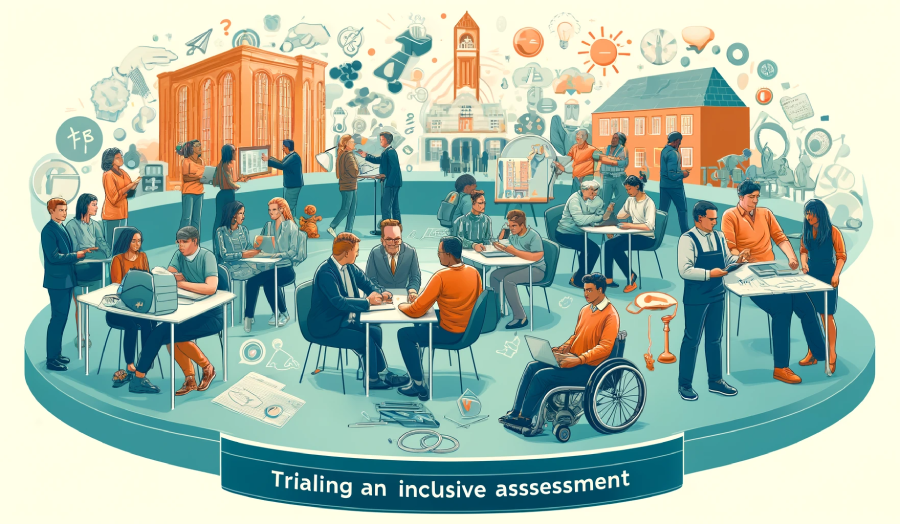What was the challenge and the context?
The level 6 module on Specific Learning Differences and neurodivergence in children (covering Autism Spectrum Disorder, Attention Deficit and Hyperactivity Disorder, Dyslexia etc) had a very traditional assessment. A 3,500-word essay was set with the same academic question for everyone - is the cause of the developmental disorder nature or nurture? And one choice: students could select the developmental disorder on which to base the essay
In response to the ESJF it was decided to develop a new assessment. The aim was to be more inclusive by giving students more choice and drawing on a wider range of their skills. There was a recognition that many students had the ability to communicate very well informally and not just academically. Many students also had direct experience of neurodiversity either for themselves or through friends and family. In addition, the aim was to enhance employability by applying their knowledge and understanding the link between research and targeted advice on neurodiversity.
What did we do?
A new assessment was developed which comprised a pamphlet and a support document. The pamphlet of 300-500 words was targeted at a particular audience and students were assessed on the appropriate choice of content for this audience (approx. 25% marks). Students were free to choose which area of neurodivergence to focus on (as before) but could also select which audience they were writing the pamphlet for. The support document of 1500-1700 words was required to justify the content of the pamphlet.
A considerable amount of preparation was needed to ensure that students fully understood and had confidence in the new assessment.
- An early briefing document was discussed with students and modified in the light of their comments
- Assessment criteria were developed and circulated
- A model pamphlet was presented (in one of the neurodiverse areas not covered in the course)
- A formative assessment was offered on the pamphlet
- Seminars were held targeted on the assessment
It was decided that the pamphlet would be assessed purely on the wording – design was not to be considered. This was because a) in a work situation it would be very likely that design would be the role of a separate team b) there was a wish to avoid students spending too long focused on design rather than wording c) the markers did not feel that they had the expertise to judge design. This approach is under review following feedback from the external examiner. Encouraging students to produce a pamphlet with design aspects as well as wording, can promote the development and practise of useful technical skills desirable to employers. This may be a useful way to adapt and improve the assignment in future.
What happened?
Student feedback was overwhelmingly positive. Students were surveyed, before they received their results, and 33 of the 58 students who submitted work responded:
| Statements from survey (33/58 students responded) | Strongly Agree & Agree | Disagree & Strongly Disagree |
|---|---|---|
| It was an interesting assignment | 91% | 9% |
| It motivated me to read about my topic | 94% | 6% |
| It allowed me to demonstrate what I had learnt | 91% | 9% |
| Writing for a non-academic audience in the Pamphlet was a useful skill to practice | 97% | 3% |
| There was enough choice embedded into the assessment so that I could explore my own interests | 88% | 12% |
| I much preferred this assignment to a traditional assessment (eg essay) | 88% | 12% |
There was no dramatic change in the grades year on year from the old assignment to the new. The average mark was slightly higher and there were fewer 1sts and no fails. This outcome would be expected from a more diversified assessment, which should allow all students to achieve well, not just a few.
Observations suggested that
- Students seemed to be more engaged – there were more questions and more discussion compared to the previous assessment
- One student commented that the assessment made it very difficult to use AI!
- The numbers of students on the module went up from 45 to 68. Perhaps they were in part attracted by the new assessment
Could the practice change be rolled out more widely?
This was a specific change in a specific module but the principles it demonstrated could be explored in modifying assessments in other areas namely:
- Giving students more choice and involving them in the design of the assessment
- Seeking to draw on a wider range of relevant skills and experience which students bring
- Making the assessment more relevant to the skills and knowledge required in employment
- Linking research more clearly to practice
But any change in assessment requires careful preparation to ensure students understand and have confidence in the new arrangements.

Key links
Presentation on this case study delivered at London Met’s Learning and Teaching conference (2023)
Presentation slides used in the session
Contact details
Email: a.holland1@londonmet.ac.uk
